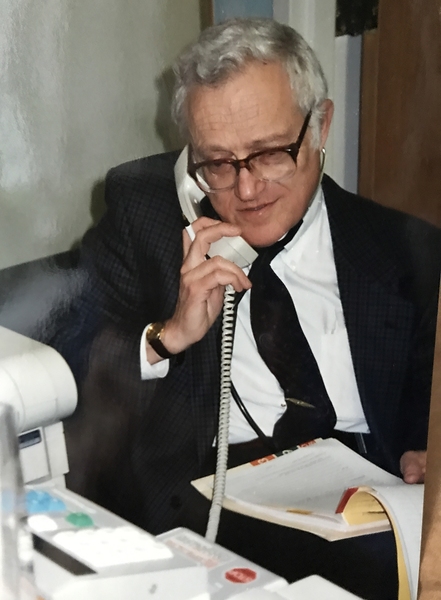Physician and former MIT faculty member Robert S. Lees died on Monday, June 5, at the age of 82, after a lengthy struggle with Alzheimer’s disease. Lees had a long and distinguished career in academic medicine. He was a cardiologist on the staff of the Massachusetts General Hospital for 50 years, as well as a professor at MIT in the Harvard-MIT Program in Health Sciences and Technology (HST). His devotion to his patients, and his remarkable skill at keeping them alive and happy for many years, were widely admired and appreciated. He made several valuable clinical and research discoveries, and was an advisor to students at MIT and HST.
Lees was born on July 16, 1934 in the Bronx, New York. He graduated magna cum laude from Harvard College in 1955 where he was elected to Phi Beta Kappa; he graduated from Harvard Medical School in 1959. He began his medical career as an intern in surgery at the Massachusetts General Hospital. In July 1960, he married Ann Mirabile, a 1961 graduate of Harvard Medical School and a long-time research colleague. Also that year, he began a yearlong clinical and research fellowship in medicine in the newly opened arteriosclerosis unit at the MGH. There, he developed a practical method for improving the diagnosis of patients with high blood lipids, the first research achievement in his long career focusing on the causes, diagnosis, and treatment of arteriosclerosis, the thickening and hardening of the artery walls.
In the following two years, he was an assistant resident in medicine at the MGH and then a fellow at the National Heart Hospital in London.
From 1963 to 1966, Lees served as a commissioned officer in the U.S. Public Health Service at the National Heart Institute of the National Institutes of Health in Bethesda, Maryland. There, he demonstrated the widespread value of the diagnostic tool he had developed at the MGH arteriosclerosis unit.
From 1966 to 1968 he was an assistant professor at the Rockefeller University in New York City. While there, he treated two young women who each had a double dose of bad genes for high blood-cholesterol. Such patients are unable to respond to any standard treatments, and they ordinarily die from coronary artery disease in their teens or early twenties. Lees developed a novel treatment to remove the lethal cholesterol from the patients’ plasma. After six months of the treatment, a form of plasmapheresis, there was marked improvement in both patients. The experiment led to a machine that is still in use to extend productive lives for patients with dangerously high cholesterol who do not respond to drugs.
When Lees became director of the MIT Clinical Research Center in 1969, he began treating two other patients who had a double dose of high blood-cholesterol genes. Treatment for one of them started when she was 16. She lived to her early 50s. The other patient, whom Lees first met when she was 3 years old, is still happily alive at the age of 51.
Lees also collaborated with an MIT professor of mechanical engineering to develop a machine that analyzed the sound waves made by blocked carotid arteries, which are located in the neck and deliver blood to the brain. The noninvasive technique used a microphone placed on the neck that sent the sound of blood flow in a blocked artery to a computer that determined how narrow the artery had become. The technique was called phonoangiography. It could measure carotid arterial narrowing to within 1 millimeter.
From 1973 to 1982, Lees was the first director of the Noninvasive Diagnostic Lab at MGH, where ultrasound was used to locate atherosclerotic plaques.
Another long-standing project was finding a way to locate atherosclerotic lesions by using compounds with a short-lived radioactive label attached. A promising element of this work was the discovery of a previously unknown protein in the artery wall. The protein, christened atherin, binds low density lipoproteins, the carriers of blood cholesterol, so tightly in the artery wall that the binding is believed to lead to atherosclerotic plaques.
From 1982 to 1991, Lees undertook clinical and research work at the New England Deaconess Hospital where he was director of medical research; after that, the work continued at the nonprofit Boston Heart Foundation in Cambridge, Massachusetts, an organization that Lees founded and directed from 1991 until retiring in December 2004.
Lees was member of the MIT Premedical Advisory Council from 1969 to 2007. He was also a member of the American Society for Clinical Investigation and the Metabolism Study Section of the National Institutes of Health, which he chaired from 1978 to 1980, as well as several other committees at MIT and Harvard Medical School. He was a fellow of the American College of Cardiology and the Council on Arteriosclerosis of the American Heart Association. He co-founded two companies, Diatide, and Atherex. He had many scientific publications and patents.
In addition to Ann Mirabile Lees, his wife of 56 years, Lees is survived by his sons, David and Steven; his daughters, Sarah and Martha; and five grandchildren.






